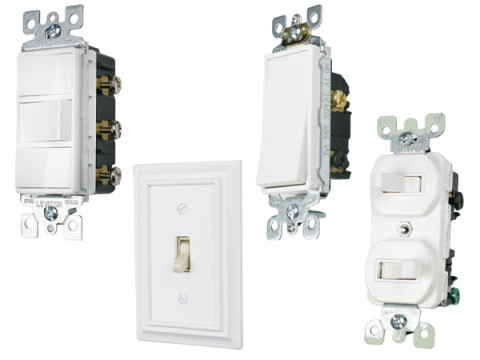Types of Light Switches: A Complete Guide
Switch Types | Special Features | Safety Tips
What Is a Light Switch?
A light switch is an essential electrical device that allows you to control the flow of electricity in a circuit. In everyday life, we use switches to turn lights and appliances on and off, making them a crucial part of any electrical system.
The primary function of a switch is to safely break an electrical current when turned off. When pressed, the internal mechanism either connects or disconnects the circuit, allowing or stopping the flow of electricity.
Types of Light Switches
Modern light switches come with advanced mechanisms that provide fast contact separation to prevent electrical arcing. While they seem simple, switches are precisely engineered to ensure efficiency, safety, and longevity.
Switches can be classified by:
- Control Mechanism (how they operate)
- Installation Type (how they are mounted)
- Special Features (dimming, automation, etc.)
Switch Types by Control Mechanism
Toggle (Rocker) Switches
The most common type, featuring a plastic or metal rocker that moves the internal contacts.
Variants include:
- Single-toggle – Controls one light source
- Double-toggle – Controls two independent circuits
- Triple-toggle – Manages multiple lighting groups
These switches are popular due to their simplicity, durability, and affordability. They work well in most residential and commercial settings.
Push-Button Switches
These switches momentarily close the circuit when pressed, returning to their original position when released.
Often used with impulse relays or smart lighting systems, modern versions may feature LED backlights and motion sensors for added convenience. Push-button switches are commonly found in public areas, stairwells, and commercial buildings.
Rotary Switches
Operated by twisting a knob, rotary switches are often used in vintage-style interiors and industrial applications.
They provide firm switching positions with a distinct clicking sound, offering both reliability and a classic aesthetic.
Switch Types by Installation Method
Surface-Mounted Switches
Installed directly on the wall, these switches do not require in-wall wiring modifications.
They are ideal for:
- Finished walls where rewiring is difficult
- Industrial and outdoor applications
- Historic buildings where hidden wiring isn't possible
Their housing extends outward, accommodating the internal mechanism without requiring a recessed box.
Recessed (Flush-Mounted) Switches
Installed within the wall using a mounting box, leaving only the decorative panel visible.
These offer a sleek, modern look and are commonly used in:
- New construction projects
- Homes with hidden electrical wiring
- Smart home systems that integrate with outlets and other components
Specialized Switches & Features
Dimmer Switches (Light Dimmers)
Dimmer switches allow you to adjust light intensity, enhancing ambiance and reducing energy consumption.
Types of dimmers:
- Rotary dimmers – Classic knob-controlled dimmers
- Touch dimmers – Adjust brightness via touch-sensitive controls
- Smart dimmers – Controlled via apps or voice assistants
⚠ Important: Not all bulbs are dimmable. Ensure compatibility before using dimmers with LED lights.
Motion Sensor Switches
Automatically turn lights on/off when movement is detected.
Best for:
- Hallways & stairwells
- Bathrooms & storage rooms
- Outdoor security lighting
Advanced models let you adjust sensitivity and timer settings for energy efficiency and convenience.
Touch-Sensitive Switches
Operate by detecting a gentle tap instead of physical movement.
Advantages:
- No mechanical parts = longer lifespan
- Sleek, modern design
- Hygienic – great for medical facilities and kitchens
Some models recognize gestures, such as short and long taps, to activate different settings.
Smart Switches & Automation
Wi-Fi Smart Switches
Connected to home automation systems, allowing remote control via smartphone apps or voice commands.
Key features:
- Schedule lighting for energy savings
- Integrate with Alexa, Google Assistant, or Apple HomeKit
- Monitor power usage from your phone
Great for home security – you can turn lights on remotely when away.
Bluetooth Switches
Offer local control without Wi-Fi, perfect for apartments or single-room setups.
They use low-energy Bluetooth to communicate with mobile apps, making them ideal for smaller-scale smart lighting solutions.
Safety Considerations When Choosing a Light Switch
For safe and reliable operation, consider these factors when selecting a switch:
Ingress Protection (IP Rating)
Indicates resistance to dust and moisture.
- Indoor use: IP20 rating is sufficient
- Bathrooms & outdoor areas: IP44 or higher for moisture resistance
Voltage & Current Rating
Ensure the switch supports your electrical system’s voltage and amperage.
- Standard home switches: 120-250V / 6-10A
- High-power applications (industrial settings): Higher-rated models required
Conclusion
Light switches play a critical role in modern electrical systems.
With a wide range of types and features, there is an ideal switch for every setting – whether it’s a basic toggle switch, a dimmer for mood lighting, or a smart switch for home automation.
When choosing a switch, prioritize safety, compatibility, and design to ensure long-lasting performance.
For a top selection of high-quality switches, explore safsale.com, where you’ll find the latest smart switches, dimmers, and motion-sensor controls for any application!

